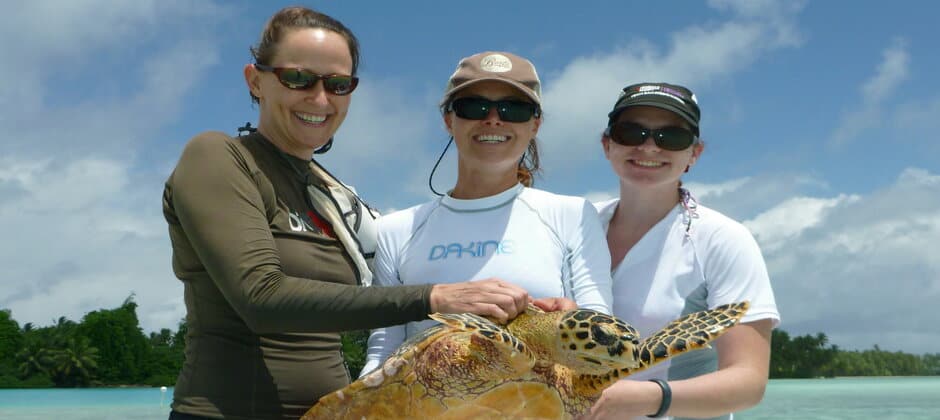Share this article
‘Forever chemicals’ may threaten Pacific sea turtles
A female hawksbill sea turtle unwittingly ingested many of the chemicals in her body while feeding off the coast of northern Oahu for several years before 2012. By the time the turtle arrived on a Maui beach to nest, it shed some of these chemicals by passing them along into its first clutch of eggs. In keeping with hawksbill (Eretmochelys imbricate) behavior, it then took off back into the ocean, returning to Maui four more times. In total, it laid eggs in five nests.
Fortunately, researchers were paying attention. They had first fitted the turtle with a satellite tracking tag in 2004. Then, they tracked it again over the course of an 8-year period as it visited the beaches of Maui to lay eggs, about once every four years. Meanwhile, scientists with the National Institute of Standards and Technology (NIST) Biorepository project, called Biological and Environmental Monitoring and Archival of Sea Turtle (BEMAST), had also collected tissue samples from the female and egg samples from each of its nests.
Looking at this data, researchers found that the turtle contained perfluoroalkyl substances (PFAS) a type of the so-called forever chemicals that have also been found in other wildlife, such as eagles in the Great Lakes. Forever chemicals got their name because these pollutants build up in the bodies of living things and don’t break down in the environment. In humans, they have been correlated with cancer, harm to the immune and reproductive systems and other problems.
“This class of chemicals is one of significant concern,” said Jennifer Lynch, a research biologist NIST and co-director of the Hawaii Pacific University Center for Marine Debris Research and one of the co-authors of a study published in Environmental Pollution analyzing the levels of these chemicals in Pacific sea turtles.
But keeping a close eye on this individual turtle was helpful — the researchers could find out even more about how the chemicals behave in Pacific sea turtles’ bodies and how the chemicals might pass to their hatchlings.
The team analyzed data collected as part of the BEMAST project, where researchers had been collecting tissue specimens of sea turtles in the Pacific Ocean and storing them in a bank since 2010. That data was used to supplement similar data the project had already gathered in the Atlantic Ocean. The project involved partnering with local and governmental organizations in Palmyra Atoll, Hawaii and the Northern Mariana Islands that conducted local sea turtle conservation work.
In this study, Lynch and her colleagues analyzed data collected from 2011 to 2013. They found that turtles from Hawaii carried the highest concentration of PFAS, followed by those from the Northern Mariana Islands, then those from Palmyra.
This isn’t necessarily surprising, Lynch said. While the entire globe has some concentration of these chemicals at this point, the levels are more pronounced where there are more humans around.
“The larger the human density is, the more contaminants we’re seeing,” she said. “The concentrations in the sea turtles are reflecting the local human land use.”
Many of these chemicals come from the types of foams used for fighting fires. These foams are often prevalent around military bases or airports, where they are used in training exercises. Hawaii has a lot of bases and airports, Lynch said, which might lead to higher concentrations of PFAS that eventually get flushed into the sea. In fact, other studies have found that sea turtle nests around international airports are afflicted with higher levels of PFAS than those farther away.
The study also revealed that hawksbill turtles had higher concentrations of PFAS than green sea turtles (Chelonia mydas). Lynch said this is likely because hawksbills eat organisms higher in the food chain like sponges and invertebrates, while green sea turtles mostly eat plants.
But by tracking the single female hawksbill dubbed Orion, the team was able to determine how the forever chemicals move through the reptiles’ systems.
“Orion is a really, really cool turtle,” Lynch said.
In 2012, researchers found that the female turtle’s first nest contained the most chemicals, and the concentration dropped in every clutch it laid after that. Generally, female turtles only swim around near the coast between every subsequent clutch without feeding before returning.
“Sea turtles probably don’t eat very much when they’re at their nesting beach,” Lynch said.
The PFAS chemicals typically bind to the blood, liver and the protein that constitutes egg whites. The researchers believe that with no new sources of PFAS coming in from feeding, the female expels less of the chemicals with every clutch.
Follow-up research would be needed to see if the hatchlings that emerged from the first nests had more health issues than those from later clutches, Lynch said. But the study indicates a possible multigenerational threat.
Header Image: A hawksbill sea turtle from Palmyra Atoll sampled for a recent study, held by Kate McFadden, Jennifer Lynch, and Frannie Nilsen, from left to right. Credit: Cheryl King








